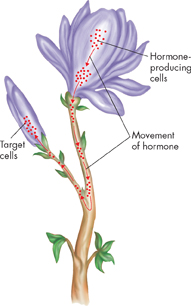24.3 Plant Hormones
 What roles do plant hormones play?
What roles do plant hormones play? What are some examples of environmental stimuli to which plants respond?
What are some examples of environmental stimuli to which plants respond? How do plants respond to seasonal changes?
How do plants respond to seasonal changes?
hormone • target cell • receptor • auxin • apical dominance • cytokinin • gibberellin • abscisic acid • ethylene • tropism • phototropism • gravitropism • thigmotropism • photoperiodism
Concept Map As you read, build a concept map summarizing the effects of different hormones on plant growth.
THINK ABOUT IT Plants, like all organisms, are collections of cells. Plants grow in response to factors such as light, moisture, temperature, and gravity. But how do roots “know” to grow down, and how do stems “know” to grow up? How do the tissues of a plant determine the right time of year to produce flowers? In short, how do the collections of cells in a plant manage to act together as a single organism? Is something carrying messages from cell to cell?
Hormones
 What roles do plant hormones play?
What roles do plant hormones play?
Hormones are chemical signals produced by living organisms that affect the growth, activity, and development of cells and tissues. In plants, hormones may act on the same cells in which they are made, or they may travel to different cells and tissues. This is in contrast to animal hormones, which typically act at a location some distance away from the cells that produce them.
 Plant hormones serve as signals that control development of cells, tissues, and organs. They also coordinate responses to the environment. The two functions fit together well, because plants respond to the environment mainly by changing their development.
Plant hormones serve as signals that control development of cells, tissues, and organs. They also coordinate responses to the environment. The two functions fit together well, because plants respond to the environment mainly by changing their development.
The steps in one mechanism of hormone action in plants is shown in Figure 24–12. In this case, the hormone moves through the plant from the place where it is produced to the place where it triggers its response.

FIGURE 24–12 Hormones and Flower Development In some species, hormone-producing cells in a mature flower release hormones that travel into flower buds and inhibit development. Once the mature flower is done blooming, production of the inhibiting hormone will decline, and the flower bud can then begin its bloom.

Table of Contents
- Formulas and Equations
- Applying Formulas and Equations
- Mean, Median, and Mode
- Estimation
- Using Measurements in Calculations
- Effects of Measurement Errors
- Accuracy
- Precision
- Comparing Accuracy and Precision
- Significant Figures
- Calculating With Significant Figures
- Scientific Notation
- Calculating With Scientific Notation
- Dimensional Analysis
- Applying Dimensional Analysis




